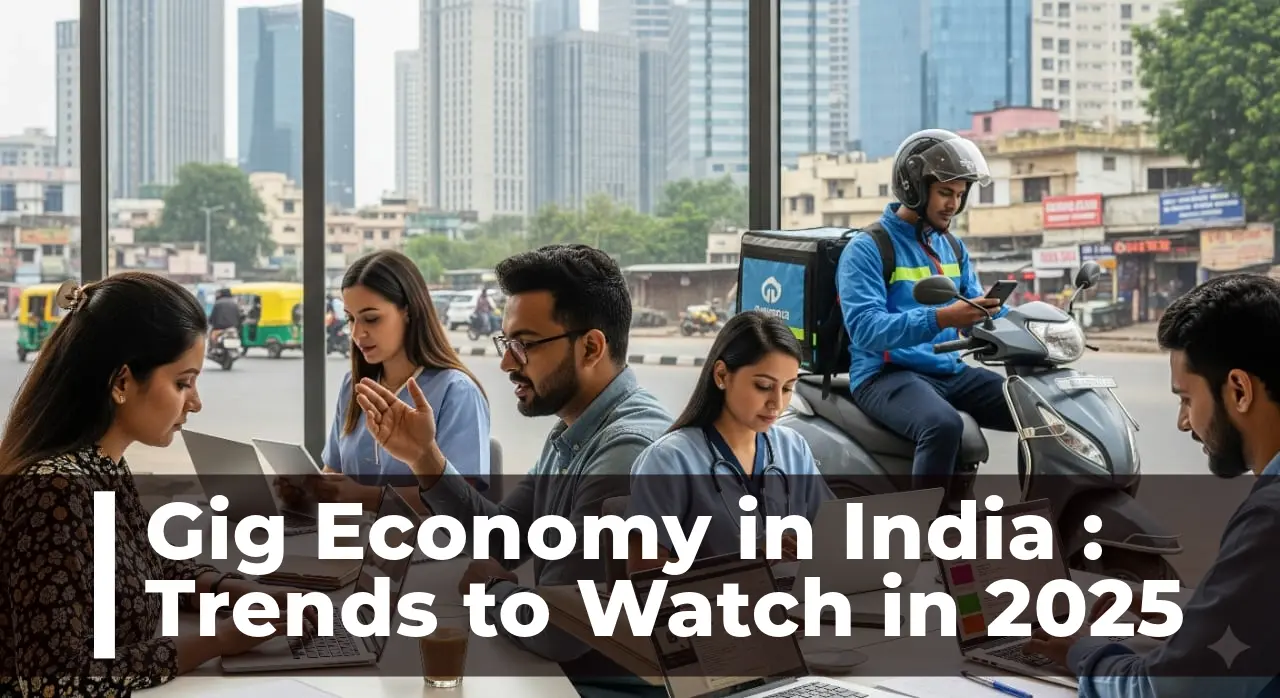Gig Economy in India: Trends to Watch in 2025
India’s gig economy in 2025 is undergoing a major shift, fuelled by AI-driven platforms, government regulations, and a surge in demand from sectors beyond food delivery and ride-hailing. Freelancers and businesses alike must adapt to this evolving landscape of flexible work and digital opportunities.

India’s gig economy has crossed a critical inflection point in 2025. The gig economy in India has evolved far beyond its early identity in delivery and transport services, expanding into technology, education, and healthcare—energized by AI-powered platforms and growing participation from tier-2 and tier-3 talent. For policymakers, workers, and businesses alike, the coming year represents both unprecedented opportunity and fresh challenges.
The Context – How India’s Gig Economy Reached 2025
From Swiggy to SaaS: The Platform Boom
The early growth of India’s gig economy was dominated by platforms like Ola, Uber, Swiggy, and Zomato. By 2025, this has diversified into SaaS-enabled gig marketplaces—connecting coders, content creators, designers, healthcare consultants, and even legal professionals with businesses worldwide.
Shifting Work Preferences Among Millennials & Gen Z
According to a NITI Aayog projection, India’s gig workforce could reach 23.5 million by 2030, but much of that acceleration is happening now. Young workers increasingly prioritize flexibility over job security, and the cultural stigma once attached to “freelancing” has largely disappeared.
The Data – Numbers Behind the 2025 Gig Economy
Market Size & Growth Projections
As per industry trackers, India’s gig economy was projected valued at $455 billion in late 2024 and early 2025, growing at nearly 17% CAGR. This makes it the second-largest gig market globally, after the US.
Sector-Wise Trends
- Logistics & Delivery: Still the largest share but slowing as automation edges in.
- IT & Digital Services: Fastest growing, with platforms like Upwork and Indian start-ups driving demand.
- Healthcare Gigs: Telemedicine and home-care nursing services have surged post-pandemic.
- EdTech & Training: Freelance tutors and course creators now form a significant slice of the pie.
Tier-2 & Tier-3 City Penetration
A striking trend is the democratization of gig work. Cities like Jaipur, Indore, and Coimbatore are emerging gig hubs, thanks to cheaper internet, AI-driven job-matching apps, and a workforce eager for supplemental income.
How India’s Workforce Is Being Reshaped
Freelancers & Independent Professionals
For freelancers, 2025 brings both empowerment and risk. While AI tools amplify productivity and broaden client pools, issues like payment security, health insurance, and retirement benefits remain unresolved.
Corporates & Start-up Ecosystem
Start-ups and corporates are increasingly building “blended workforces”—mixing permanent staff with project-based freelancers. This reduces costs and allows agile scaling, but also demands new HR tech to manage compliance.
Policymakers & Labour Rights Concerns
The government has introduced early frameworks for gig worker social security—including accident insurance and pension schemes—but enforcement remains patchy. 2025 may mark the first year of serious policy-driven formalization in this sector.
The Expert View – 2025 and Beyond
- Labour Economist: “The gig economy is no longer a fringe phenomenon; it is central to India’s workforce strategy. However, unless labour laws catch up, precarity will remain a concern.”
- Start-up Founder: “We see gig workers as India’s next export—delivering not just food, but digital services to global markets.”
- Gig Worker Testimonial: “AI has doubled my output as a designer, but I still worry about unpredictable income. Stability matters as much as freedom.”
FAQ – India’s Gig Economy 2025
Q. “How large has India’s gig workforce grown by 2025?
Ans. India’s gig economy is valued at around $455 billion in 2025, making it one of the fastest-growing freelance markets in the world.
Q. Which sectors are hiring most gig workers?
Ans. Logistics and delivery remain dominant, but IT, healthcare, and education gigs are rapidly gaining share in 2025.
Q. Are gig workers getting social security in India?
Ans. Yes, the Indian government has initiated social security frameworks including accident insurance and pensions, though enforcement is still limited.
Q. How is AI impacting the gig economy?
Ans. AI is enabling smarter job matching, boosting productivity, and opening global markets, but it is also automating some traditional gig roles.
Q. What does the future of gig work in India look like?
Ans. India’s gig economy is expected to become more formalized, diversified across sectors, and globally competitive by 2030.
Conclusion – The Road Ahead
In India, gig work has moved from the side-lines to the centre of the employment landscape. By 2025, the lines between permanent employment and freelance contracts are blurring, creating a new hybrid model of work. The winners in this landscape will be those who balance flexibility with security, and technology with empathy. The question for India isn’t if the gig economy will expand—it’s whether the expansion can balance flexibility with worker protection.



